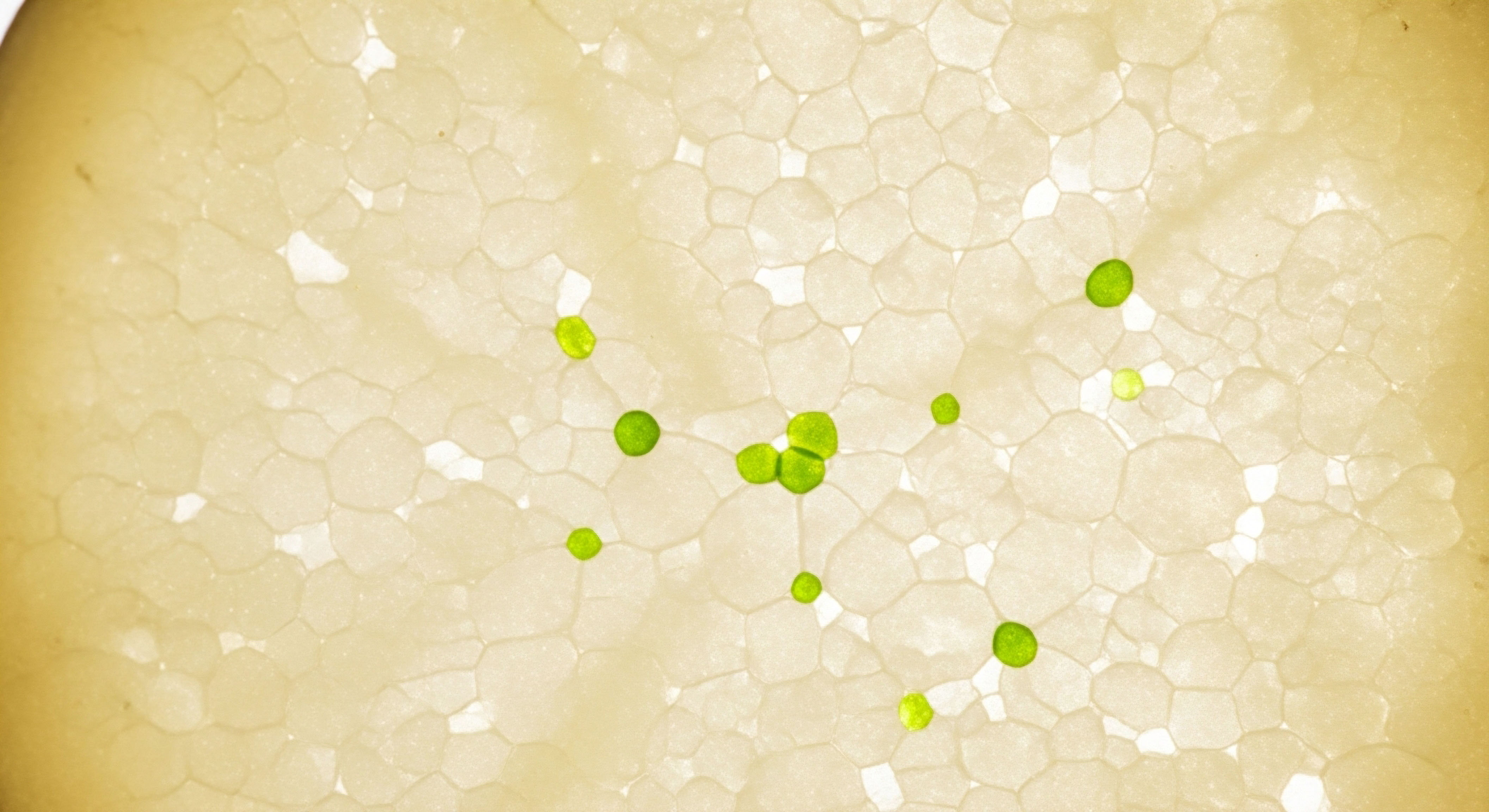

Fundamentals
Observing more hair in your brush or on your pillow can be a deeply personal and unsettling experience. It often begins subtly, a quiet change that you might initially dismiss. Yet, the persistence of this change can create a current of concern that runs through your daily life.
This experience is a valid and tangible signal from your body, a communication that the internal environment is under a significant load. The resilience of your hair is a direct reflection of your systemic well-being. Understanding this connection is the first step toward addressing the root cause, moving from a state of concern to one of informed action.
Your hair follicles are not simply passive structures. Each one is a highly active, complex mini-organ embedded within your scalp, operating according to a precise, cyclical clock. This cycle dictates whether a hair is growing, resting, or shedding. To appreciate how we can support this process, we must first understand its phases:
- Anagen Phase ∞ This is the active growth phase. Cells in the root of the hair are dividing rapidly, and the new hair pushes the old club hair (a hair that has stopped growing) up the follicle and eventually out. At any given time, a majority of your hair is in this phase, which can last for several years.
- Catagen Phase ∞ A transitional stage that lasts for a few weeks. During this time, growth stops, and the outer root sheath shrinks and attaches to the root of the hair. This is the formation of what is known as a club hair.
- Telogen Phase ∞ This is the resting phase. The follicle is completely at rest, and the club hair is fully formed. Hairs in this phase, which typically lasts for a few months, are eventually shed to make way for a new anagen hair.
This entire cycle is exquisitely sensitive to the body’s internal chemical messengers. Hormones, growth factors, and nutrients provide the essential signals that tell a follicle to remain in the growth phase or to transition prematurely into resting and shedding. When the body is under pressure ∞ from psychological stress, metabolic dysfunction, or hormonal shifts ∞ the balance of these signals can be disrupted.
The hair growth cycle is a dynamic process that can be significantly influenced by the body’s systemic stress levels and hormonal balance.

The Architecture of Pressure and Its Impact on Hair
When we speak of “pressure,” we are describing a biological reality. Chronic stress, whether emotional or physiological, triggers the release of hormones like cortisol from the adrenal glands. Cortisol is a primary actor in the body’s stress response system, designed for short-term survival. However, when its levels remain persistently high, it sends disruptive signals throughout the body. The hair follicle is particularly receptive to these signals.
Elevated cortisol can shorten the anagen (growth) phase and push a larger number of follicles into the telogen (resting) phase. This condition, known as telogen effluvium, results in diffuse shedding and a noticeable thinning of hair density.
The pressure also manifests as inflammation and reduced blood flow to the scalp, further depriving the follicles of the oxygen and nutrients required for robust growth. It creates an environment where resilience is compromised, and the follicles’ ability to sustain healthy growth is diminished.
This is where the conversation about targeted interventions begins. The goal is to counteract these disruptive signals at the cellular level. We aim to create a more favorable biochemical environment for the hair follicle, one that promotes growth and fortifies it against the pressures of modern life. Peptide therapies represent a sophisticated approach to providing these precise, supportive signals, helping to restore the delicate balance required for healthy hair cycling.


Intermediate
To truly comprehend how we can bolster hair follicle resilience, we must examine the specific biological mechanisms that are compromised under pressure. The connection between systemic stress and hair health is not abstract; it is a direct, cause-and-effect relationship mediated by precise molecular pathways. Targeted peptide therapies are designed to intervene in these pathways, offering a way to recalibrate the cellular environment of the scalp and support the follicle’s inherent potential for growth.

The Molecular Cascade of Stress-Induced Hair Loss
The primary antagonist in the narrative of stress-related hair loss is cortisol. Persistently elevated cortisol levels initiate a cascade of negative effects within the microenvironment of the hair follicle. Firstly, cortisol can directly suppress the proliferation of dermal papilla cells, which are the “command center” of the follicle, orchestrating the hair growth cycle.
Secondly, it has been shown to reduce the synthesis of key structural components like proteoglycans, which are essential for anchoring the hair in the follicle and maintaining its structural integrity. A reduction in these molecules weakens the hair’s foundation, making it more prone to premature shedding.
Furthermore, cortisol disrupts the local production of crucial growth factors. One of the most important is Vascular Endothelial Growth Factor (VEGF), which is responsible for angiogenesis ∞ the formation of new blood vessels. A rich blood supply is non-negotiable for a healthy follicle, as it delivers the oxygen and nutrients necessary for the high metabolic activity of the anagen phase.
By impairing blood flow, stress effectively starves the follicle. Another critical player is Insulin-like Growth Factor 1 (IGF-1), which is known to prolong the anagen phase. Cortisol can suppress local IGF-1 signaling, pushing the follicle toward the catagen and telogen phases prematurely.
Peptide therapies function by introducing specific signaling molecules that can counteract cortisol-induced damage and promote a pro-growth environment within the scalp.

How Do Peptides Intervene in Follicle Resilience?
Peptides are short chains of amino acids that act as highly specific biological messengers. Unlike broad-spectrum treatments, they can be designed to target distinct cellular receptors and pathways. This precision allows for a sophisticated approach to restoring the conditions necessary for healthy hair growth. Several classes of peptides have demonstrated significant potential in this arena.

Growth Hormone Secretagogues the Systemic Approach
A foundational strategy for enhancing overall tissue regeneration, including that of hair follicles, involves optimizing the growth hormone (GH) and IGF-1 axis. Peptides like Ipamorelin and CJC-1295 are growth hormone secretagogues, meaning they signal the pituitary gland to release the body’s own natural growth hormone.
This elevation in GH leads to a subsequent increase in systemic and local IGF-1 levels. As established, IGF-1 is a potent stimulator of the anagen phase. By creating a more favorable systemic hormonal milieu, these peptides can provide a powerful, foundational support for hair follicle function, improving cellular repair and encouraging a longer growth phase.

Locally-Acting Peptides the Direct Intervention
Other peptides work directly at the level of the scalp and follicle, providing targeted repair and stimulation. Two prominent examples are GHK-Cu and BPC-157.
- GHK-Cu (Copper Tripeptide-1) ∞ This peptide, a complex of the peptide GHK and a copper ion, is a powerhouse of regenerative signaling. Its mechanisms are multifaceted. It is a potent anti-inflammatory, helping to quell the chronic, low-grade inflammation that stress induces in the scalp. GHK-Cu also stimulates the production of collagen and elastin, improving the structural integrity of the skin and the anchoring of the follicle. Critically, it promotes angiogenesis via VEGF production and has been shown to increase the size of the hair follicle itself, leading to thicker, stronger hair shafts. Some research also suggests it may act as a 5-alpha reductase inhibitor, reducing the conversion of testosterone to DHT, a hormone implicated in androgenetic alopecia.
- BPC-157 (Body Protective Compound 157) ∞ While renowned for its systemic healing properties, particularly in soft tissues, BPC-157’s mechanisms are highly relevant to hair follicle resilience. Its primary strength lies in its ability to accelerate wound healing and promote angiogenesis. It can help repair micro-damage within the scalp tissue caused by inflammation and oxidative stress. By significantly enhancing blood vessel growth, it ensures that follicles under pressure receive an improved supply of vital nutrients, creating a more robust environment for sustained growth.
The following table provides a comparative overview of these key peptides and their primary mechanisms of action related to hair follicle support.
| Peptide Protocol | Primary Mechanism | Effect on Hair Follicle | Mode of Administration |
|---|---|---|---|
| Ipamorelin / CJC-1295 | Stimulates endogenous Growth Hormone release, increasing systemic IGF-1. | Prolongs anagen (growth) phase; improves overall cellular repair and vitality. | Subcutaneous Injection |
| GHK-Cu | Promotes angiogenesis, collagen synthesis, and reduces inflammation. | Increases follicle size, improves scalp health, and enhances nutrient delivery. | Topical (Foam/Serum) or Micro-injection |
| BPC-157 | Accelerates tissue repair and potently stimulates new blood vessel formation (angiogenesis). | Repairs scalp micro-damage and dramatically improves blood flow to the follicle. | Subcutaneous Injection or Topical |
By combining systemic support with targeted local action, a multi-faceted protocol can be developed. This approach does not just mask the symptoms of hair thinning; it addresses the underlying biological disruptions that pressure creates, rebuilding the resilience of the hair follicle from both the inside out and the outside in.


Academic
An academic exploration of peptide therapy for hair follicle resilience requires a granular analysis of the cellular and molecular crosstalk that governs follicular cycling. The hair follicle is a self-renewing system whose fate is dictated by a complex interplay between endocrine signals, local growth factors, neuropeptides, and the immune system.
Chronic stress, acting through the hypothalamic-pituitary-adrenal (HPA) axis, introduces a profoundly disruptive variable into this equation. The strategic application of specific peptides can be viewed as a form of molecular intervention designed to restore homeostasis within this intricate regulatory network.

The HPA Axis and Its Destabilizing Influence on Follicular Stem Cell Quiescence
At the heart of stress-induced hair loss is the over-activation of the HPA axis and the resultant hypersecretion of glucocorticoids, principally cortisol. Recent research has elucidated the precise mechanism by which cortisol impacts the hair follicle stem cells (HFSCs) that are responsible for initiating the anagen phase. In a state of chronic stress, elevated cortisol levels were found to suppress the secretion of a key signaling molecule, Growth Arrest-Specific 6 (Gas6), from the dermal papilla cells.
Gas6 is a vitamin K-dependent protein that acts as a ligand for the AXL family of receptor tyrosine kinases, which are expressed on HFSCs. The binding of Gas6 to its receptor is a critical signal that awakens the quiescent stem cells, prompting them to proliferate and regenerate the lower part of the follicle, thereby initiating a new growth phase.
By inhibiting Gas6 production, cortisol effectively locks the HFSCs in a state of prolonged dormancy. This extends the telogen phase and prevents the follicle from re-entering anagen, leading to the clinical presentation of telogen effluvium. This provides a direct molecular link between a systemic stress hormone and the behavior of a specific stem cell niche.

Can Peptide Therapy Modulate the HPA-HFSC Axis?
While no single peptide directly injects Gas6, several therapeutic peptides can modulate the upstream and downstream factors influencing this pathway. Growth hormone secretagogues like Sermorelin, CJC-1295, and Ipamorelin function by stimulating the pulsatile release of endogenous growth hormone, which in turn elevates hepatic and local production of IGF-1.
IGF-1 is a potent mitogen for multiple cell types within the follicle and is known to be a key factor in maintaining the anagen phase. Its signaling pathway, the PI3K-Akt pathway, is a powerful counter-regulatory force against the pro-apoptotic and anti-proliferative effects of glucocorticoids. By bolstering the IGF-1 axis, these peptides may create a cellular environment that is less permissive to cortisol’s inhibitory effects, potentially restoring the dermal papilla’s capacity to secrete activating factors like Gas6.

The Role of Neuropeptides and Local Inflammation
The skin has its own peripheral neuro-endocrine system. Stress can also trigger the release of neuropeptides like Substance P (SP) from cutaneous nerve endings. SP can induce degranulation of mast cells surrounding the hair follicle, releasing a host of pro-inflammatory mediators, including Tumor Necrosis Factor-alpha (TNF-α). This neurogenic inflammation contributes to a state of perifollicular micro-inflammation that is hostile to hair growth and can induce premature catagen entry, a process known as “follicular distress.”
This is where peptides with potent cytoprotective and anti-inflammatory properties become particularly relevant. BPC-157 has demonstrated a remarkable ability to counteract inflammatory cascades. While its exact receptor is still under investigation, it appears to modulate the nitric oxide (NO) system and downregulate inflammatory cytokines like TNF-α. By mitigating the neurogenic inflammation triggered by stress, BPC-157 can help preserve the integrity of the follicular microenvironment.
Similarly, GHK-Cu has been shown to suppress inflammatory cytokine levels, including TGF-β and TNF-α. Transforming Growth Factor-beta (TGF-β) is a potent catagen-inducing cytokine. By lowering the levels of both TNF-α and TGF-β in the perifollicular environment, GHK-Cu directly counteracts two of the key molecular drivers that push a follicle out of the anagen phase.
The following table details the specific molecular targets of these peptides in the context of counteracting stress-induced follicular damage.
| Peptide | Molecular Target/Pathway | Scientific Rationale for Hair Follicle Resilience |
|---|---|---|
| Ipamorelin/CJC-1295 | GHRH receptor agonism, leading to increased GH/IGF-1 axis activity. | Upregulates the pro-survival and pro-proliferative PI3K-Akt pathway, counteracting glucocorticoid-induced suppression of anagen. |
| GHK-Cu | Modulation of gene expression for collagen, elastin, and metalloproteinases; suppression of TGF-β and TNF-α. | Rebuilds the extracellular matrix, reduces catagen-inducing cytokines, and promotes a pro-angiogenic environment. |
| BPC-157 | VEGFR2 activation; modulation of the NO system; downregulation of inflammatory pathways. | Promotes robust angiogenesis to nourish the follicle and mitigates stress-induced neurogenic inflammation. |

What Are the Commercial Implications for Peptide Formulations in China?
The development and marketing of peptide-based hair treatments in China must navigate a complex regulatory landscape governed by the National Medical Products Administration (NMPA). Products may be classified as cosmetics, which have a more streamlined registration process, or as drugs, which require extensive clinical trials demonstrating safety and efficacy.
A topical peptide foam, for instance, might be positioned as a “special use cosmetic” for hair growth, requiring rigorous safety assessments and human efficacy testing. Injectable peptides fall squarely into the drug category, demanding a far more substantial investment in clinical research to gain approval. The commercial strategy would depend on the chosen peptide, its mechanism, and the claims being made, balancing regulatory burden against market potential in a country with a growing demand for advanced aesthetic and wellness solutions.
In conclusion, a systems-biology perspective reveals that targeted peptide therapies can support hair follicle resilience by intervening at multiple nodes within the complex network that is disrupted by chronic stress. They can act systemically to buffer against the hormonal consequences of HPA axis activation and locally to mitigate inflammation, promote angiogenesis, and provide the specific signals needed to maintain the anagen phase. This represents a sophisticated, mechanism-based approach to a common and distressing clinical problem.

References
- Choi, F. D. Sung, C. T. Juhasz, M. L. & Mesinkovska, N. A. “The Role of Copper in Human Health.” Journal of the American Academy of Dermatology, vol. 80, no. 6, 2019, pp. 1781-1788.
- Pickart, L. & Margolina, A. “Regenerative and Protective Actions of the GHK-Cu Peptide in the Light of the New Gene Data.” International Journal of Molecular Sciences, vol. 19, no. 7, 2018, p. 1987.
- Hsieh, Y. J. et al. “Pentadecapeptide BPC 157 Enhances the Growth Hormone Receptor Expression in Tendon Fibroblasts.” Molecules, vol. 22, no. 9, 2017, p. 1466.
- Teichman, S. L. et al. “Prolonged Stimulation of Growth Hormone (GH) and Insulin-Like Growth Factor I Secretion by CJC-1295, a Long-Acting Analog of GH-Releasing Hormone, in Healthy Adults.” The Journal of Clinical Endocrinology & Metabolism, vol. 91, no. 3, 2006, pp. 799-805.
- Choi, Y. S. et al. “A Randomized, Double-Blind, Placebo-Controlled Study on the Efficacy of a Combination of Biomimetic Peptides in the Treatment of Telogen Effluvium.” Journal of Cosmetic Dermatology, vol. 17, no. 5, 2018, pp. 836-843.
- Arck, P. C. et al. “The Pathophysiology of Stress-Induced Hair Growth Inhibition.” Journal of Investigative Dermatology, vol. 123, no. 1, 2004, pp. 1-10.
- Peters, E. M. J. et al. “Neurotrophic and Nerve-Growth-Factor ∞ Related Molecules in the Human Hair Follicle.” Journal of Investigative Dermatology, vol. 126, no. 4, 2006, pp. 877-887.
- Foitzik, K. et al. “TGF-β1 inhibits hair growth by shortening anagen and initiating follicle catagen.” The American Journal of Pathology, vol. 156, no. 4, 2000, pp. 1139-1148.
- Zhang, H. et al. “Glycine-Histidine-Lysine (GHK) Alleviates Neuronal Apoptosis Due to Intracerebral Hemorrhage via the MiR-339-5p/VEGFA Pathway.” Frontiers in Neuroscience, vol. 12, 2018, p. 644.
- Paus, R. & Cotsarelis, G. “The Biology of Hair Follicles.” The New England Journal of Medicine, vol. 341, no. 7, 1999, pp. 491-497.

Reflection

Translating Knowledge into Personal Strategy
You have journeyed through the intricate biology of the hair follicle, from its fundamental growth cycles to the complex molecular signals that govern its response to pressure. This knowledge provides a powerful framework for understanding your own body’s signals. The changes you observe are not random; they are part of a coherent biological narrative.
The information presented here is a map, detailing the terrain of hormonal influence, stress pathways, and cellular communication. It illuminates the mechanisms through which resilience can be compromised and, more importantly, how it can be rebuilt.
The path forward involves moving from this general map to your specific territory. Your biological individuality is the context in which all this science operates. The next step is to consider how these systems function within you.
Reflect on the sources of pressure in your own life ∞ be they metabolic, hormonal, or environmental ∞ and recognize them as tangible inputs that your body is processing. This awareness is the foundation of any effective wellness protocol. The science provides the tools, but your personal health journey dictates how they are best applied. This understanding is the true starting point for reclaiming vitality and function, empowering you to build a personalized strategy for enduring resilience.



